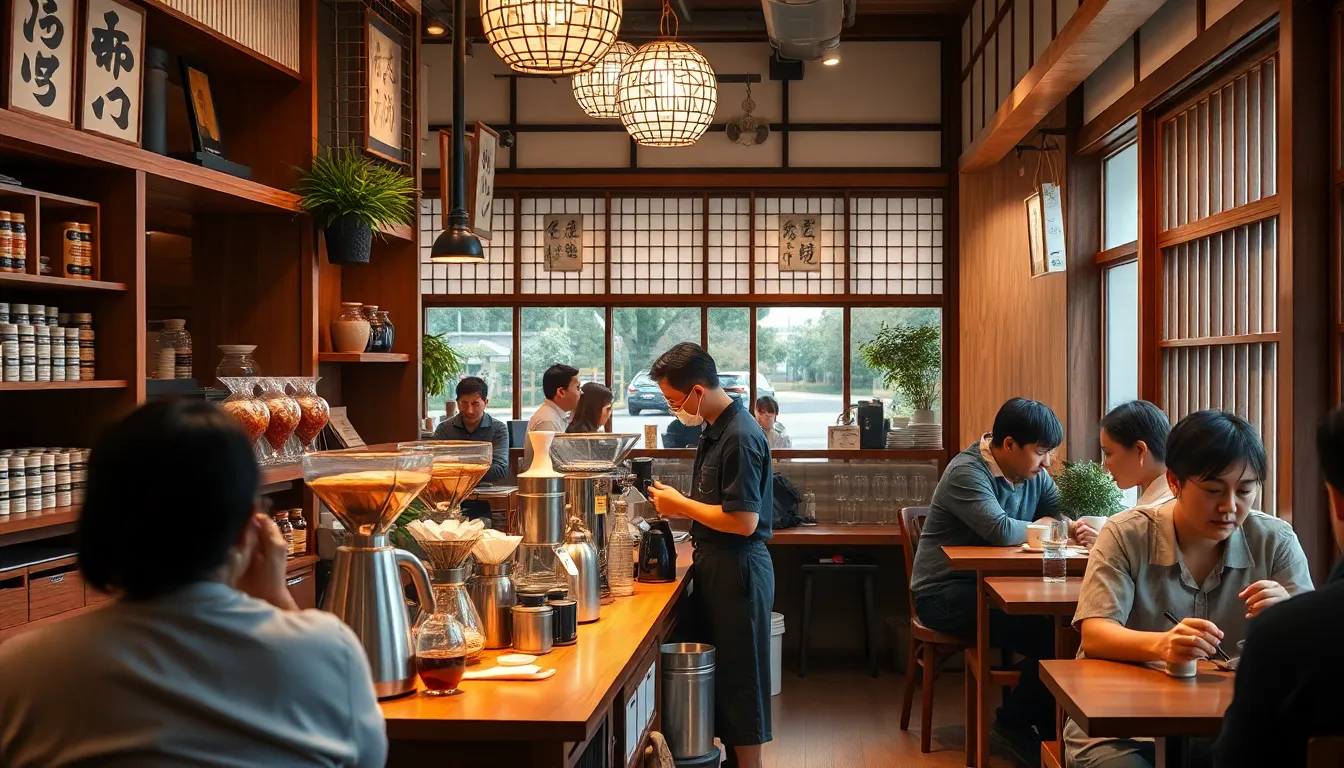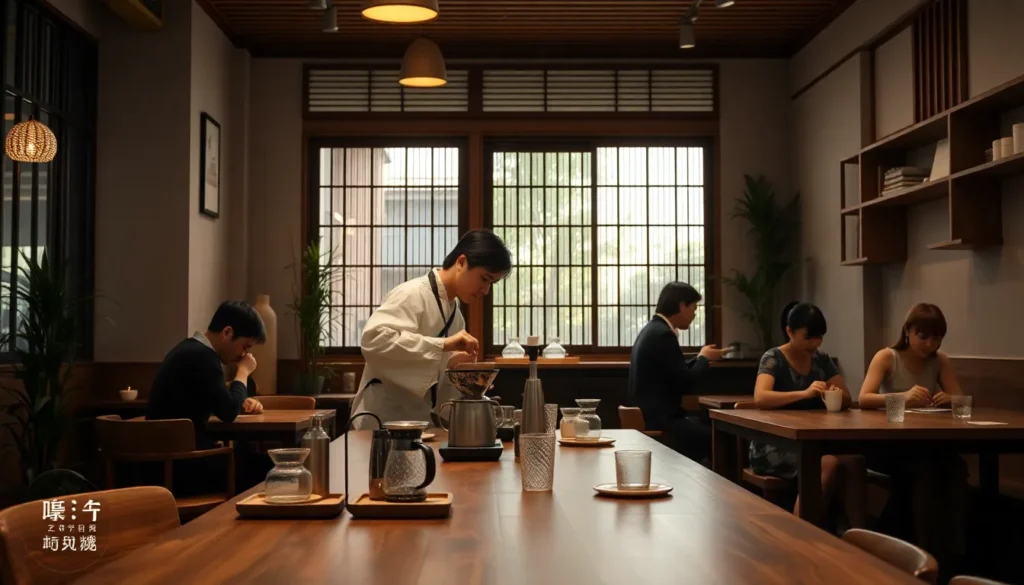Table of Contents
ToggleIn a world where coffee is often just a means to fuel the daily grind, Japan takes this beloved beverage to a whole new level. Picture this: meticulously brewed cups of coffee served with the precision of a samurai sword. Japanese coffee culture isn’t just about caffeine; it’s an art form that blends tradition and innovation.
Overview of Japanese Coffee Culture
Japanese coffee culture transforms coffee into a refined experience, emphasizing precision and artistry. Enthusiasts appreciate the thoughtful brewing methods. Traditional techniques draw inspiration from centuries-old practices, with each step requiring careful attention.
Coffee shops serve as community hubs, offering various brews, from pour-overs to siphon coffee. Pour-over coffee demands a meticulous approach; water temperature and pouring speed significantly impact flavor profiles. Siphon brewing showcases elaborate techniques, combining visual appeal with rich taste.
In recent years, Japan has embraced innovative approaches to coffee. The introduction of specialty coffee shops highlights global trends while maintaining a local identity. Baristas experiment with diverse beans, pushing boundaries in flavors and aromas.
Cafés also incorporate unique aesthetics, often reflecting minimalism found in traditional Japanese design. A serene atmosphere enhances the coffee experience, allowing patrons to savor each sip fully. Some establishments even offer tasting menus, inviting customers to explore various flavor notes in a single sitting.
Japan’s coffee culture doesn’t just celebrate the drink itself. It fosters community engagement and encourages connections among coffee lovers. Exhibitions and competitions promote craftsmanship, elevating the status of baristas and roasters alike.
Understanding Japanese coffee culture provides insight into a unique blend of tradition and innovation, showcasing Japan’s dedication to quality and artistry in every cup.
Historical Background

Japan’s coffee culture boasts a rich history that intertwines tradition with modernity. The arrival of coffee introduced a new beverage, sparking interest in innovative brewing techniques.
The Introduction of Coffee to Japan
Coffee made its debut in Japan in the 17th century, brought by Dutch traders. The beverage initially gained popularity in Nagasaki, serving as a curiosity among the elite. By the early 20th century, Western influence propelled coffee further into Japanese society, encouraging coffee houses to open in urban areas. These establishments offered an alternative to traditional tea, attracting a diverse clientele eager to experience this novel drink.
Evolution Over Time
Over time, Japan’s approach to coffee transformed significantly. The post-war era marked a shift, as American military influence introduced instant coffee to the market. However, the 1980s brought a resurgence of interest in artisanal practices. Coffee enthusiasts began to appreciate globally sourced beans and meticulous brewing methods. This evolution coincided with the rise of specialty cafes, which emphasize quality and craftsmanship. Today, Japan’s coffee culture reflects a harmonious blend of historical significance and contemporary innovation.
Unique Coffee Preparation Methods
Japan boasts a range of unique coffee preparation methods that showcase its dedication to quality and artistry. These techniques elevate the coffee experience beyond mere consumption.
Pour Over Techniques
Pour over techniques stand out for their focus on precision. Baristas meticulously control water temperature and flow rate, allowing them to extract nuanced flavors from the beans. Popular pour over devices include the Hario V60 and Kalita Wave. These tools use a cone-shaped design, promoting even extraction. Each cup prepared this way provides a clean and vibrant taste, highlighting the coffee’s natural characteristics. Regular competitions, such as the All Japan Coffee Cat Competition, emphasize skills in pour over brewing, fostering innovation among coffee professionals.
Siphon Brewing
Siphon brewing captivates both coffee enthusiasts and casual drinkers. This method employs vapor pressure to brew coffee, creating a theatrical experience. Coffee grounds sit in a top chamber while water heats in the bottom chamber, generating steam. Once the pressure builds, water rises, immersing the coffee grounds, producing a rich brew. After heat is removed, brewed coffee returns to the bottom chamber through a filter, ensuring clarity in taste. Siphon brewing highlights the chemistry of coffee, making each cup an engaging experience to savor.
Coffee Shops and Cafés
Japan’s coffee shops and cafés showcase a blend of tradition and modernity. These spaces create environments where coffee becomes an experience rather than just a beverage.
Traditional Kissaten
Kissaten serve as classic establishments that prioritize the art of coffee. Patrons find a tranquil ambiance, with many kissaten offering retro decor and low lighting. Baristas in these shops often employ time-honored brewing methods, such as siphon and hand-drip techniques, ensuring each cup reflects skill. Many make coffee using high-quality beans, with particular emphasis on regional sourcing. Customers enjoy the ritualistic experience, taking time to appreciate rich flavors and aromas. Moreover, kissaten often serve light meals, boasting options like toast and parfaits, which enhances the experience of savoring coffee.
Modern Specialty Cafés
Modern specialty cafés emphasize innovation and creativity in coffee preparation. These venues attract a younger crowd eager to explore diverse flavor profiles. Baristas experiment with various brewing methods, such as pour-overs and cold brews, showcasing their craft. Many cafés revolve around sustainability, choosing to work with ethically sourced beans. Customers appreciate detailed tasting notes on each menu, which guide them through the flavor journey. Furthermore, events like coffee cupping allow enthusiasts to delve deeper into the nuances of coffee, fostering community engagement and knowledge sharing. Overall, these modern spaces reflect Japan’s dynamic coffee culture, blending artistry with a passion for exploration.
Influence on Global Coffee Trends
Japan’s coffee culture significantly impacts global coffee trends through its unique practices and emphasis on quality. Traditional brewing techniques inspire baristas around the world, showcasing meticulous approaches to flavor extraction. Techniques like pour-over and siphon brewing have gained popularity internationally, prompting coffee enthusiasts to adopt these practices in their cafés.
Specialty coffee shops increasingly integrate elements of Japanese culture, blending precision with creativity. Baristas experiment with techniques and flavors, resulting in innovative coffee offerings that appeal to diverse palates. As Japanese methods gain traction, many cafés feature similar minimalist aesthetics, prioritizing a serene environment for patrons to enjoy their coffee fully.
Coffees sourced from Japan often highlight flavor profiles not commonly found elsewhere. Various beans undergo careful selection, emphasizing unique tasting notes that reflect local terroirs. The growing global interest in Japanese coffee contributes to an appreciation of specific brewing equipment, leading many baristas to invest in artisanal tools like the Hario V60 and other precision devices.
Competitions play a role in shaping these trends, as barista contests elevate skills and creativity. Events such as the All Japan Coffee Cat Competition draw attention to innovative brewing techniques, inspiring café owners to adapt and refine their methodologies. Success in these competitions often translates into recognition within the broader coffee community, influencing trends beyond Japan.
Cafés in Japan also serve as blueprints for community engagement. Many establishments host coffee tasting events or workshops that foster collective appreciation for coffee culture. This model helps cultivate a global network of coffee lovers focused on quality and artisanal methods. Overall, Japan’s influence on the global coffee scene continues to enrich the coffee experience through dedication to craftsmanship and innovation.
Japan’s coffee culture stands out for its blend of tradition and innovation. The meticulous brewing methods elevate coffee into an art form that captivates enthusiasts and casual drinkers alike. Each cup reflects a commitment to quality and craftsmanship that resonates deeply within the community.
As coffee shops continue to evolve, they foster connections among patrons while pushing the boundaries of flavor. The emphasis on unique preparation techniques and minimalist aesthetics creates an inviting atmosphere for exploration. This dedication not only enriches the local experience but also influences coffee trends worldwide.
Japan’s coffee culture is a testament to the beauty of combining history with modern practices, making every sip a delightful journey into the heart of its rich heritage.







